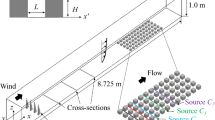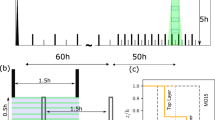Abstract
To provide additional field data for assessingwindbreak flow models, mean ground-level pressurehas been measured upstream and downstream from along porous fence (height H = 1.25 m, resistancecoefficient k r = 2.4). Measurements were madeduring periods of near-neutral stability and near-normallyincident flow, with the fence standing on bare soil(roughness length, z 0 ≈ 0.8 cm;H/z 0 ≈ 160), or within a plant canopy. The mean pressure field,measured far from the ends of the fence, was foundto be quite insensitive to mean wind direction(\(\bar \alpha\), zero for perpendicular flow), for|\(\bar \alpha\)| less than about 25°.
In the absence of a canopy, during each measurementperiod the minimum pressure occurred at the closestsampling location to leeward of the windbreak, thepressure-gradient in most cases beingmaximally-adverse in the immediate lee, and decayingwith increasing downwind distance (x). On one day ofmeasurements, however, the pressure gradient over2 ≈ x/H ≈ 6 (H = windbreak height) resembled theleeward ‘plateau’ identified by Wang and Taklein their numerical studies. Perhaps this‘occasional’ feature was only due to instrumenterror. Nevertheless a ‘plateau’ of sorts wasindicated in similar measurements by Judd andPrendergast (with H = 1.92 m, z 0 ≈ 1.2 cm;H/z 0 ≈ 160, k r ≈ 3). Therefore,existence of a leeward pressure plateau behind athin fence cannot be definitely ruled out.
When the windbreak was placed in a canopy, minimumsurface pressure was displaced downwind. Thisagrees with the wind-tunnel study of Judd, Raupach and Finnigan,and is consistent with a simple simulation reported here.
Similar content being viewed by others
References
Argete, J. C. and Wilson, J. D.: 1989, 'The Microclimate in the Centre of Small Square Sheltered Plots', Agric. For. Meteorol. 48, 185–199.
Bradley, E. F. and Mulhearn, P. J.: 1983, 'Development of Velocity and Shear Stress Distributions in the Wake of a Porous Shelter Fence', J. Wind Eng. Indust. Aerodyn. 15, 145–156.
Cowan, I. R.: 1968, 'Mass, Heat and Momentum Exchange Between Stands of Plants and Their Atmospheric Environment', Quart. J. Roy. Meteorol. Soc. 94, 523–544.
Finnigan, J. J. and Bradley, E. F.: 1983, 'The Turbulent Kinetic Energy Budget Behind a Porous Barrier: An Analysis in Streamline Coordinates', J. Wind Eng. Indust. Aerodyn. 15, 157–168.
Hagen, L. J., Skidmore, E. L., Miller, P. L., and Kipp, J. E.: 1981, 'Simulation of Effect of Wind Barriers on Windflow', Trans. ASAE 24, 1002–1008.
Jacobs, A. F. G.: 1984, 'Static Pressure Around a Thin Barrier', Arch.Met. Biocl., Ser. B 35, 127–135.
Jackson, P. S. and Hunt, J. C. R.: 1975, 'Turbulent Wind Flow Over a Low Hill', Quart. J. Roy. Meteorol. Soc. 101, 929–955.
Judd, M. J., Raupach, M. R., and Finnigan, J. J.: 1996, 'A Wind Tunnel Study of Turbulent Flow Around Single and Multiple Windbreaks, Part I: Velocity Fields', Boundary-Layer Meteorol. 80, 127–165.
Judd, M. J. and Prendergast, P. T.: 1996, 'Pressure and Turbulence Measurements Around a Windbreak', Internal Report No. 96/220, Hort. & Food Res. Inst. P.O. Box 23, Kerikeri, New Zealand.
Launder, B. E., Reece, G. J., and Rodi, W.: 1975, 'Progress in the Development of a Reynolds-Stress Turbulence Closure', J. Fluid Mech. 68, 537–566.
Patankar, S. V.: 1980, Numerical Heat Transfer and Fluid Flow, Series in Computational Methods in Mechanics and Thermal Sciences, Hemisphere Publishing Co., London, 197 pp.
Patankar, S. V.: 1981, 'A Calculation Procedure for Two-Dimensional Elliptic Situations',Numerical Heat Transfer 4, 409–425.
Patton, E. G., Sullivan, P. P., Shaw, R. H., Paw U, K. T., and Moeng, C. H.: 1996, 'A Nested-Grid Large Eddy Simulation of Turbulent Flow Above and Within a Forest', Preprint volume for 22nd Conference of the AMS on Agric. Forest Meteo, Atlanta, pp. J41–J42.
Press, W. H., Flannery, B. P., Teukolsky, S. A., and Vetterling, W. T.: 1988, Numerical Recipes in C, Cambridge University Press, Cambridge, 735 pp.
Schlichting, H.: 1968, Boundary-Layer Theory, 6th edition, McGraw-Hill, 748 pp.
Schmidt, R. A., Takle, E. S., Brandle, J. R., and Litvina, I. V.: 1995, 'Static Pressure at the Ground Under Atmospheric Flow Across a Windbreak', Preprint volume for 11th Symposium of the AMS on Boundary Layers and Turbulence, Charlotte, NC, pp. 517–520.
Schwartz, R. C., Fryrear, E. W., Harris, B. L., Bilbro, J. D., and Juo, A. S. R.: 1995, 'Mean Flow and Shear Stress Distributions as Influenced by Vegetative Windbreak Structure', Agric. For. Meteorol. 75, 1–22.
Takle, E. S. and Wang, H.: 1997, 'Reply to Comments by J. D. Wilson and C. J.Mooney', Boundary-Layer Meteorol. 85, 151–159.
Wang, H. and Takle, E. S.: 1995, 'A Numerical Simulation of Boundary-Layer Flows Near Shelterbelts', Boundary-Layer Meteorol. 75, 141–173.
Wang, H. and Takle, E. S.: 1996a, 'On Three-Dimensionality of Shelterbelt Structure and Its Influences on Shelter Effects', Boundary-Layer Meteorol. 79, 83–105.
Wang, H. and Takle, E. S.: 1996b, 'Momentum Budget and Shelter Mechanism of Boundary-Layer Flow Near a Shelterbelt', Boundary-Layer Meteorol. 82, 417–435.
Wilson, J. D. and Mooney, C. J.: 1997, 'Comments on “A Numerical Simulation of Boundary-Layer Flows Near Shelterbelts” by H. Wang and E. Takle', Boundary-Layer Meteorol. 85, 137–149.
Wilson, J.D., Finnigan, J. J., and Raupach, M. R.: 1997, 'A First-Order Closure for Disturbed Plant Canopy Flows, and Its Application to Windflow Through a Canopy on a Ridge', Quart. J. Roy. Meteorol. Soc., in press.
Wilson, J. D., Swaters, G. E., and Ustina, F.: 1990, 'A Perturbation Analysis of Turbulent Flow Through a Porous Barrier', Quart. J. Roy. Meteorol. Soc. 116, 989–1004.
Wilson, J. D.: 1988, 'A Second-Order Closure Model for Flow Through Vegetation',Boundary-Layer Meteorol. 42, 371–392.
Wilson, J. D.: 1985, 'Numerical Studies of Flow Through a Windbreak', J.Wind Eng. Indust. Aerodyn. 21, 119–154.
Wilson, N. R. and Shaw, R. H.: 1977, 'A Higher Order Closure Model for Canopy Flow', J. Appl. Meteorol. 16, 1197–1205.
Author information
Authors and Affiliations
Rights and permissions
About this article
Cite this article
Wilson, J.D. A Field Study of the Mean Pressure About a Windbreak. Boundary-Layer Meteorology 85, 327–358 (1997). https://doi.org/10.1023/A:1000582917218
Issue Date:
DOI: https://doi.org/10.1023/A:1000582917218




